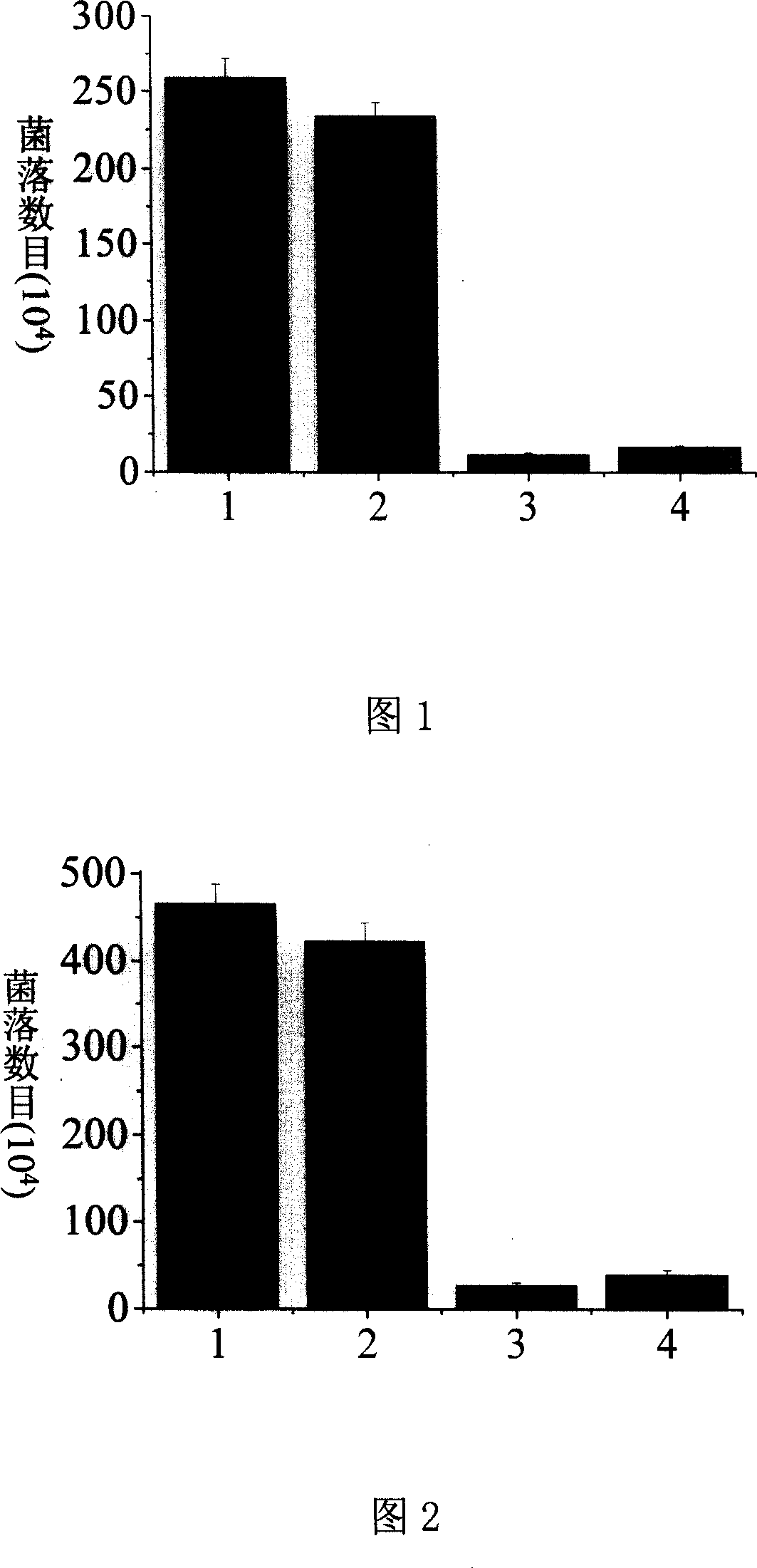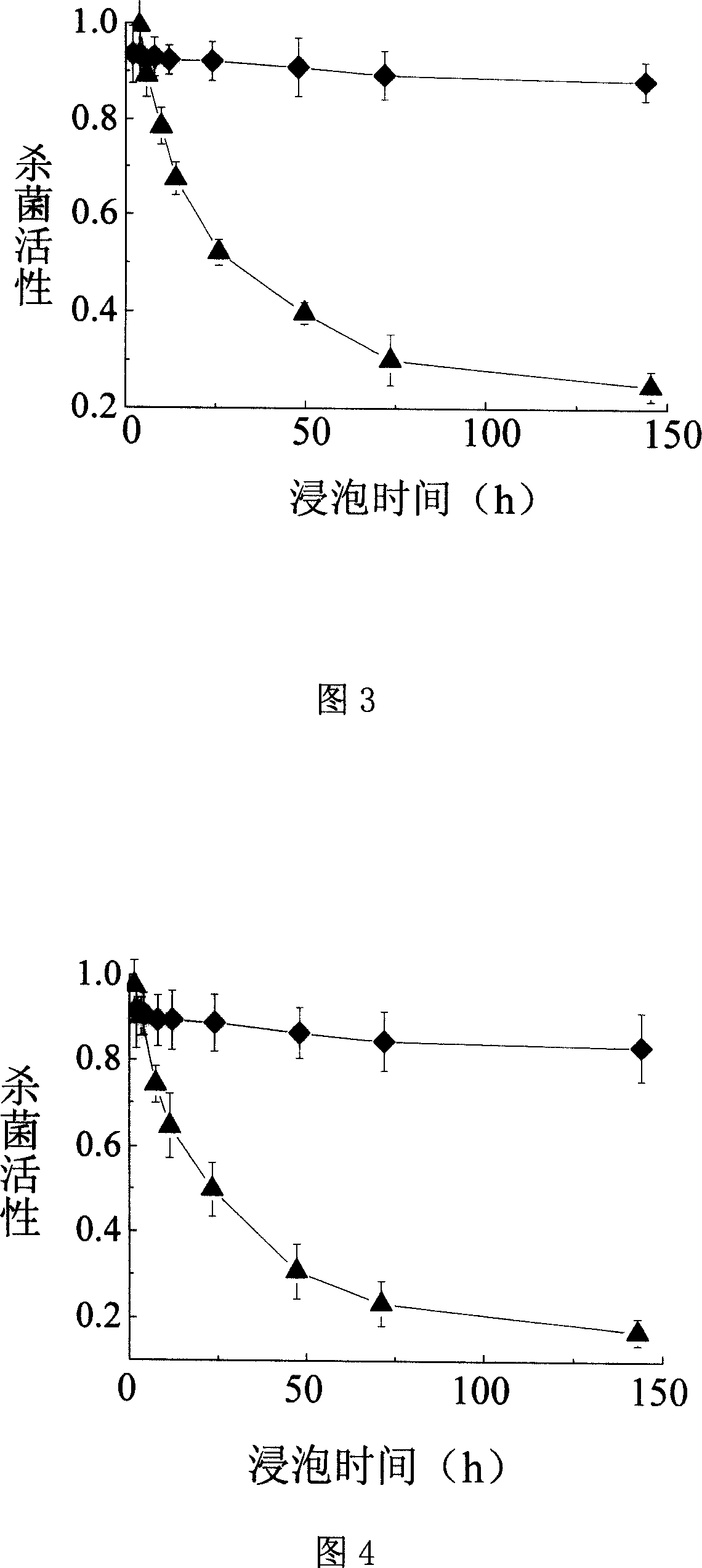Process for preparing antibiotic-peptide modified-fibroin film material
A silk protein and antimicrobial peptide technology, applied in medical science, absorbent pads, bandages, etc., can solve problems such as the emergence of immature technology, low antibiotics, and human side effects, and achieve bacterial infection and long-lasting antibacterial properties The effect of antimicrobial properties
- Summary
- Abstract
- Description
- Claims
- Application Information
AI Technical Summary
Problems solved by technology
Method used
Image
Examples
Embodiment 1
[0040] (1) use Na 2 CO 3 Solution (concentration 5g / L) scouring the cocoon layer 3 times to remove the soluble protein on the surface of silk protein—sericin and other impurities, 30min each time, scouring temperature 98°C, bath ratio 1:100;
[0041](2) After washing and drying, the silk protein was dissolved in 9 mol / L lithium bromide aqueous solution at 40°C. The obtained solution was dialyzed in distilled water for 3 days to remove lithium bromide to obtain an aqueous solution of silk protein, and the solution concentration (w / v) was 2%;
[0042] (3) spread the silk protein solution on a polystyrene petri dish, and dry naturally at 37°C to obtain a silk protein film;
[0043] (4) Soak the silk protein film in the mixed solution of alcohol and water for 20 minutes to make the film insoluble in water, wherein the volume percentage of alcohol is 60%;
[0044] (5) Soak and dry the silk protein film in phosphate buffer (0.1mol / L Na 2 HPO 4 , 0.5mol / L NaCl, pH6.5) soaked for...
Embodiment 2
[0049] The steps of this embodiment are all the same as in Embodiment 1, wherein:
[0050] In step (1), Na 2 CO 3 The concentration of the solution is 1g / L;
[0051] In step (2), the silk protein dissolution temperature is 30°C, the concentration of the lithium bromide aqueous solution is 8mol / L, and the concentration (w / v) of the silk protein aqueous solution is 0.1%;
[0052] In step (4), the volume percentage of alcohol is 50%, and the soaking time is 40 minutes;
[0053] In step (5), the soaking time of silk protein film in phosphate buffer solution is 45 minutes;
[0054] In step (6), the silk protein film is immersed in the mixed solution for 25 minutes, and the components and concentration of the mixed solution: 1-(3-dimethylaminopropyl)-3-ethylcarbodiimide hydrochloride is 0.1 mg / mL, N-hydroxysuccinimide is 0.1mg / mL;
[0055] In step (7), the reaction time is 0.5 hour, and the concentration of the antimicrobial peptide in the buffer is 0.01 mg / mL.
Embodiment 3
[0057] The steps of this embodiment are all the same as in Embodiment 1, wherein:
[0058] In step (1), Na 2 CO 3 The concentration of the solution is 8g / L;
[0059] In step (2), the silk protein dissolution temperature is 70°C, the concentration of the lithium bromide aqueous solution is 10mol / L, and the concentration (w / v) of the silk protein aqueous solution is 20%;
[0060] In step (4), 100% pure alcohol is used, and the soaking time is 10 minutes;
[0061] In step (5), the soaking time of silk protein film in phosphate buffer solution is 15 minutes;
[0062] In step (6), the silk protein film is soaked in the mixed solution for 45 minutes, and the mixed solution components and concentration: 1-(3-dimethylaminopropyl)-3-ethylcarbodiimide hydrochloride is 1mg / mL, N-hydroxysuccinimide is 1mg / mL;
[0063] In step (7), the reaction time is 1 hour, and the concentration of the antimicrobial peptide in the buffer is 1 mg / mL.
[0064] The special feature of the present inv...
PUM
| Property | Measurement | Unit |
|---|---|---|
| Diameter | aaaaa | aaaaa |
Abstract
Description
Claims
Application Information
 Login to View More
Login to View More - R&D
- Intellectual Property
- Life Sciences
- Materials
- Tech Scout
- Unparalleled Data Quality
- Higher Quality Content
- 60% Fewer Hallucinations
Browse by: Latest US Patents, China's latest patents, Technical Efficacy Thesaurus, Application Domain, Technology Topic, Popular Technical Reports.
© 2025 PatSnap. All rights reserved.Legal|Privacy policy|Modern Slavery Act Transparency Statement|Sitemap|About US| Contact US: help@patsnap.com


